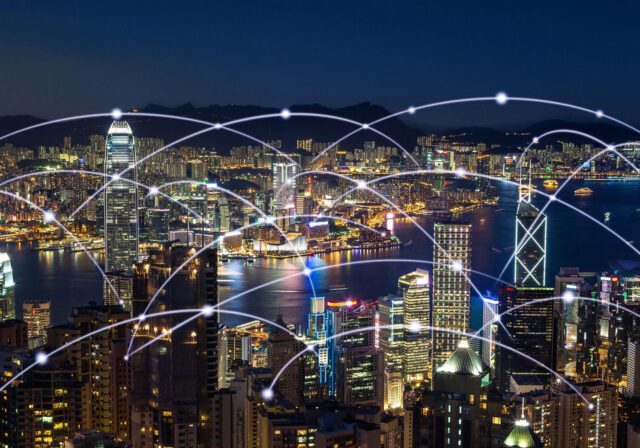Fiber is a completely different type of infrastructure that transmits your data at nearly the speed of light. While the technology is cutting edge, understanding it doesn’t have to be complicated. Let’s break down what fiber optic internet is, how it delivers data, what happens behind the scenes, and why it outperforms other internet types so consistently.
What is fiber optic internet?
Fiber optic internet is a type of broadband internet that uses fiber optic cables, thin strands of glass or plastic that transmit data using pulses of light. These cables are capable of sending massive amounts of information over long distances with minimal interference or signal loss.
What makes fiber different? Light vs. electricity
Most traditional internet services (like cable and DSL) rely on electrical signals that travel over copper wires. But fiber internet uses something totally different: light.
Why light? 3 reasons:
- It experiences less resistance than metal (copper) wires.
- There are no distance limitations on optical fibers.
- It carries more data at once.
In short: it offers more speed, more stability, and more capacity.
How fiber brings internet to your home: A 6-step journey
Fiber internet transmits data by converting digital signals (text, images, videos) into pulses of light using lasers or LEDs. When the pulses of light reach their destination, like your home, they are converted back into electrical signals by a device called an Optical Network Terminal (ONT). The ONT then sends this data to your modem or router, giving internet access to all your devices.
Here’s a more detailed six-step version of how fiber internet works from end to end:
- Data originates from a central server or data center (think Netflix, Zoom, Google Drive).
- That data travels over the global internet backbone, a network of high-capacity fiber lines that span continents and oceans.
- The signal arrives at your local internet service provider (ISP) hub or central office, where it enters the access network for your neighborhood or city.
- A fiber line runs from this hub to your area. This might be to a nearby street cabinet (FTTC), to your building (FTTB), or all the way to your home (FTTH).
- Once the fiber line reaches your home, it connects to the ONT device we discussed earlier, which translates the light signal into an electrical one.
- That electrical signal is passed to your fiber internet router, which then distributes the internet connection to your devices wirelessly.
So, even though you’re watching a movie on your phone in bed, the data that might’ve started on a server hundreds of miles away is now at your fingertips at nearly the speed of light.
Fiber internet infrastructure: 3 components
Let’s take a closer look at some of the fiber internet terms we used above to get an even better understanding. Fiber internet infrastructure is generally divided into three main components:
1. Backbone networks
This is the superhighway of the internet. Backbone networks are massive, high-capacity fiber-optic lines that connect cities, states, and even countries. They’re built for speed and distance, allowing enormous amounts of data to travel quickly and efficiently across long stretches of land (or ocean).
2. Local distribution networks
Once data hits your region, it needs to be routed to individual neighborhoods. That’s where local fiber distribution networks come in. These smaller-scale lines branch off from the backbone and carry data closer to homes, businesses, schools, and other local destinations.
3. Last-mile delivery: FTTH vs. FTTN
The “last mile” is the final stretch of the journey, from the local distribution line to your actual home. There are two main ways this is delivered:
- Fiber-to-the-Home (FTTH): Fiber lines run directly into your residence, giving you the fastest, most reliable internet experience available today, making this type of fiber delivery the gold standard.
- Fiber-to-the-Node (FTTN): Fiber lines stop at a nearby node (like a street cabinet), and the remaining distance to your home is covered by traditional copper wiring. It's faster than DSL or cable, but not quite as powerful as full FTTH.
5 advantages of fiber internet
Fiber’s performance doesn’t just come from its speed. It also comes from the way the infrastructure is designed. Here are a five factors that set it apart from the rest:
- Symmetrical (or nearly symmetrical) speeds: Supports equal (or nearly equal) upload and download speeds, which is ideal for cloud backups, video calls, and remote work. It’s not just about how fast you can stream, it’s how fast you can send.
- Less signal degradation: Doesn’t suffer from the same distance-based slowdowns that copper does. Signals can travel miles with little to no loss in quality.
- Bandwidth and stability: Handles multiple devices seamlessly, even during peak usage.
- Low latency: Ideal for real-time applications like live streaming, virtual reality, augmented reality, and intense gaming sessions.
- Resistance to weather and interference: Unlike copper, fiber isn’t affected by electromagnetic interference, moisture, or lightning. That means more consistent service, rain or shine.
3 challenges of fiber internet
Despite its clear advantages, fiber internet has some challenges:
- Installation costs: Fiber generally requires professional installation, which can be costly compared to other options like 5G Home Internet, for example. Some ISPs, however, may cover the cost for new customers.
- Limited availability: While fiber networks are expanding quickly, they’re still not everywhere. Many rural and even some suburban areas don’t yet have access to full fiber service. That’s because building out fiber infrastructure is a big investment, and providers often focus on high-density areas first.
- Complex deployment: Fiber deployment involves careful planning, permits, and construction efforts. Even if service is available in your neighborhood, you may have to wait days or weeks for physical installation, especially for FTTH setups that require digging or new lines.
The future of fiber internet
Fiber internet is only getting faster, smarter, and more accessible as ISP networks expand and cities invest in broadband infrastructure. With emerging technologies like Wi-Fi 7, cloud gaming, AR/VR, and AI-powered smart homes, fiber’s bandwidth and low latency make it the most future-ready connection available. Whether you’re streaming in 8K or running a remote office, fiber is built to handle whatever comes next.
T-Mobile Fiber offers gigabit speeds, no caps on data usage, a Wi-Fi mesh extender access point, if needed, and more. Plus, T-Mobile Fiber is continually expanding into new markets. See if it’s available at your address.
Want to try a fast, reliable fixed wireless option? Try T-Mobile 5G Home Internet, America’s fastest growing home internet provider.
*Fastest based on analysis by Ookla® of Speedtest Intelligence® data of national Speed Score results incorporating 5G download and upload speeds for 1H 2025. Ookla trademarks used under license and reprinted with permission. See 5G device, coverage, & access details at T-Mobile.com.
You may be interested in:
- What is Fiber Internet?
- What is Broadband?
- All Things Fiber Optic Internet Cables
- DSL vs. Fiber vs. Cable vs. 5G Home Internet
- What is Wi-Fi?
- Upload vs. Download Speed: What You Need to Know
- Is 5G Home Internet Service Faster Than Regular Wi-Fi?
Sources:
https://www.geeksforgeeks.org/computer-networks/what-is-the-internet-backbone
https://tinifiber.com/a-deep-dive-into-how-fiber-optic-cables-work
https://www.dcconnectglobal.com/zh/last-mile/
https://www.zdnet.com/home-and-office/networking/fiber-vs-cable-what-is-the-difference
https://tripplite.eaton.com/products/fiber-optic-cable-buying-guide
https://www.lumitex.com/blog/optical-fiber-technology
https://www.c1c.net/blog/the-pros-cons-and-difference-between-cable-and-fiber-optic-internet/
https://t-mobilefiber.com/fiber-internet-service/benefits-of-fiber-internet-speed-and-wifi-6
https://www.techtarget.com/searchnetworking/definition/fiber-to-the-homehttps://www.cnet.com/home/internet/fiber-internet-explained/



